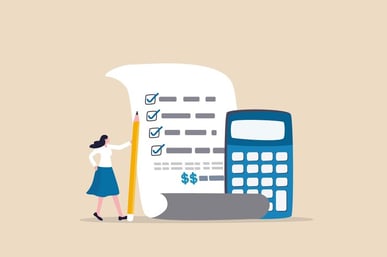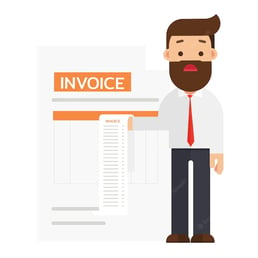Quote vs Invoice - What's The Difference
Invoicing and billing are critical processes within any business. But what happens when the lines between them are blurred?
You might be surprised to learn that only some invoices are created equal. For example, some businesses use a quote-based approach, where invoices are generated based on a verbal agreement with the customer. Others prefer to issue an invoice with every order, regardless of size.
Which method works best for your company? You can learn more about quotes vs invoices in this article.
Whether you own a small company or on a large scale, it is important to know the difference between a quote and an invoice. So, what is the difference between a quote and an invoice?
A quote is an estimate of what a job will cost, while invoices are requests for payment due for work that has been performed already.
Knowing when to provide a quote vs an invoice can mean the difference between getting paid promptly and being stuck chasing down payments. This article will cover everything that you need to know about quotes and invoices, including when to use each.
What Is a Quote?

When billing your clients for services rendered, you may wonder whether to send a quote or an invoice. Both are similar in that they outline the costs of a job, but there are some key differences.
A quote is the estimated full cost of a product or service before production starts. In some cases, quotes are based on the manufacturer's or service provider's recommendations, but in other cases, they're just pulled out of thin air. Either way, the aim is to get a good estimate without negotiating with the customer.
In the eyes of the customer, a quote is simply an estimate. They know that the price quote might change, but it'll at least be a good starting point for negotiations. What's important is that the quote matches what was promised. In other words, the quote is accurate, specific, and valuable.
A quote is typically used when the final cost of services is unknown. For example, if you are hiring a contractor to build a house, they will provide you with a quote outlining the estimated labour and materials full cost. Once the work is completed, the contractor will send an invoice for the actual cost of the services rendered.
Finalizing a Quote
When you're ready to finalize a quote, keep a few things in mind.
- First, make sure you're clear on the scope of work. What exactly are you and the customer agreeing to? Once you've got that nailed down, it's time to put together your pricing.
- Be sure to include any discounts or promotions that may apply.
- Finally, remember to add your terms and conditions. This lets the customer know what they can expect from you and vice versa.
With all this in mind, you're ready to finalize your quote and start the project!
When To Use a Quote?
A quote is typically used when you're providing open-ended services or when the scope of work is still being determined. This way, your client has an estimate of what they can expect to pay.
So, when should you use a quote? If you're still working out the details of a project or the scope of work is subject to change, then a quote is probably the best option. This way, your client knows approximately how much they'll be paying.
Benefits of Providing a Quote
When it comes to providing a quote for services, there are many benefits that businesses can take advantage of. By providing a quote, businesses can:
- Give the potential customer an idea of what they will be charged.
- Build trust and credibility with the potential customer.
- Help the potential customer understand what services will be provided.
- Eliminate any surprises for the potential customer regarding pricing.
- Streamline the payment process for both parties involved.
- Offer discounts or other incentives to customers who book based on a quote.
- Make it easier to keep track of spending for both parties involved.
What Is an Invoice?

An invoice is a document that details the cost of a product or service sold to a customer. In most cases, invoices are created simultaneously when the quote is given to the customer. However, some businesses enter a product's production phase before issuing a final invoice, which means that the invoice doesn't always match the quote. In these cases, the invoice often serves as a reference point for further negotiation between the business and the customer.
An invoice template is usually a simple, single-page document that lists the goods or services sold to the customer and the full cost. It can also include a description of the work performed and a due date for payment. However, invoices can be lengthy, so keeping everything to one page is essential to maintain a clean look. Once the customer has paid the invoice, they'll receive a receipt indicating the amount owed and the due date.
When To Use an Invoice?
As discussed above, only some invoices are created equal. Some businesses use a 'pull quote' approach, where no invoice is created until there's actual payment. In this scenario, the quote and the invoices are the same. Once the customer pays the bill, they'll receive a receipt with the due date and a copy of the invoice. This is a commonly used approach in the medical world because it's difficult to prove the exact cost of services like surgery and medication.
However, as a business owner, you need to determine when to issue an invoice based on the size of the order and your unique circumstances. For example, if you're entering a new market and need more experience, it is not a good idea to quote the customer the cost of production. Instead, it will help if you wait until you have established reliable contact with the customer and build a relationship. An Invoice software can help you here.
What's Included in an Invoice?
An invoice is a document businesses send customers to request payment due for products or services. An invoice includes
- The date of purchase
- The customer's name
- Contact information
- A description of the product or service
- The unit prices
- The quantity purchased
- The total amount due
- Any applicable taxes
Businesses may also include terms of payment on the invoice.
Customers should review their invoices carefully to ensure they are being charged the correct amount for the products or services they have received. If there are discrepancies, customers should contact the business to resolve the issue. Likewise, businesses should keep accurate records of their invoices in case there are any disputes about payments.
Invoice payments are typically due within 30 days of receipt. Businesses may charge late fees if payments are not received within this timeframe.
How Does the Invoice Process Work?
The invoice process is a critical part of any business transaction. Let's look at how it works and what you should know to make it run smoothly.
When a customer requests a quote for goods or services, the business creates an invoice and sends it to the customer. The customer then has the option to accept or reject the quote. If they accept, they'll pay the invoiced amount. They may ask for a revised quote or walk away if they reject.
Invoices can be paid in cash, by credit card, or by check. Businesses usually require payment within Thirty days of receipt of the invoice. However, some businesses offer discounts for early payment, so it's always worth checking the terms of your invoice before you pay.
Quote vs Invoice
When billing your clients, you have two options: quotes and invoices. But what's the difference between the two?
A quote is an estimate of the cost of services to be provided. It's not a binding document, so that the price can change. On the contrary, an invoice is a request for payment due for services rendered. The price quote on an invoice is set in stone.
So, which one should you use? It depends on your business and your relationship with your client. If you're starting, use quotes to adjust your prices as needed. However, invoices are usually the way to go once you've established yourself.
Of course, there can always be exceptions to this rule.
When billing customers, many businesses use the terms quote and invoice interchangeably. However, there is a big difference between the two documents. Businesses should take care to use the correct document when billing their customers. Using a quote when an invoice is due can confuse and may even result in non-payment. On the other hand, issuing an invoice when a quote is expected can lead to frustration on the customer's end.
It is crucial to know when to use a quote and an invoice to avoid misunderstandings. A good rule of thumb is to issue a quote whenever the price of goods or services is unclear or subject to change.
Conclusion
While both documents are important, they serve different purposes. A quote is used to give the customer an estimate of the project's cost. An invoice is used for billing the customer for the work that has been completed.
Knowing these two documents' differences will help you run your business more efficiently. For example, use quotes to give customers an estimate of the full cost of a project and use invoices to bill for work that has been completed.
Both quote and invoice processes rely on one another for smooth cash flow. However, computers have made great strides in streamlining these processes. Fortunately, modern technology has devised ways to automate these manual processes. Save time and money, and avoid unnecessary stress using our estimate and invoice software. Sign up for a free trial now! Get your quotes and invoices done in minutes, not days.

